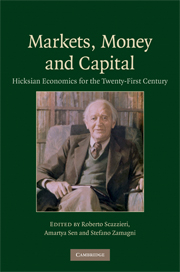Book contents
- Frontmatter
- Contents
- List of figures
- List of tables
- List of contributors
- Preface and acknowledgments
- Between theory and history: on the identity of Hicks's economics
- Part I The Intellectual Heritage of John Hicks
- Part II Markets
- Part III Money
- Part IV Capital and Dynamics
- 15 ‘Distribution and Economic Progress’ after seventy years
- 16 Flexible saving and economic growth
- 17 The economics of non-linear cycles
- 18 A perspective on a Hicksian non-linear theory of the trade cycle
- 19 Capital, growth, and production disequilibria: on the employment consequences of new technologies
- 20 Capital and time
- 21 Sequential analysis and out-of-equilibrium paths
- References
- Name index
- Subject index
15 - ‘Distribution and Economic Progress’ after seventy years
Published online by Cambridge University Press: 29 June 2009
- Frontmatter
- Contents
- List of figures
- List of tables
- List of contributors
- Preface and acknowledgments
- Between theory and history: on the identity of Hicks's economics
- Part I The Intellectual Heritage of John Hicks
- Part II Markets
- Part III Money
- Part IV Capital and Dynamics
- 15 ‘Distribution and Economic Progress’ after seventy years
- 16 Flexible saving and economic growth
- 17 The economics of non-linear cycles
- 18 A perspective on a Hicksian non-linear theory of the trade cycle
- 19 Capital, growth, and production disequilibria: on the employment consequences of new technologies
- 20 Capital and time
- 21 Sequential analysis and out-of-equilibrium paths
- References
- Name index
- Subject index
Summary
Introductory remarks
The Theory of Wages, published in 1932, was John Hicks's first book. I was surprised to discover (from a later ‘Commentary’) that he began professional life fresh out of Oxford as a labor economist whose first two published articles dealt with wages in the building trades and the history of industrial conciliation in the United Kingdom (Hicks, 1963: 318).
In his ‘Commentary’ on the original text, Hicks remarks that 1932 was the worst possible time to produce a rather classical book on the theory of wages. Edward Chamberlin's treatise on monopolistic competition and Joan Robinson's on imperfect competition came out in 1933, and John Maynard Keynes was already beginning to develop the ideas that became The General Theory. Hicks was unaware of any of this. He was ‘out of tune’ with Cambridge.
He tells an entertaining story about his first visit to the United States in 1946 (ibid.: 311). He found that he was being welcomed, not as the author of Value and Capital (1939a), of which he was proud, but as the author of The Theory of Wages, which he was in a mood to repudiate. He mentions a dinner at Harvard with a small group of ‘eminent economists’ unnamed except for Joseph Schumpeter, though I could make an educated guess at some of the others. ‘[W]e spent the evening, I trying to persuade them that [it] was a thoroughly bad book, they trying to persuade me that it was a good one.’
- Type
- Chapter
- Information
- Markets, Money and CapitalHicksian Economics for the Twenty First Century, pp. 277 - 286Publisher: Cambridge University PressPrint publication year: 2009
- 1
- Cited by



